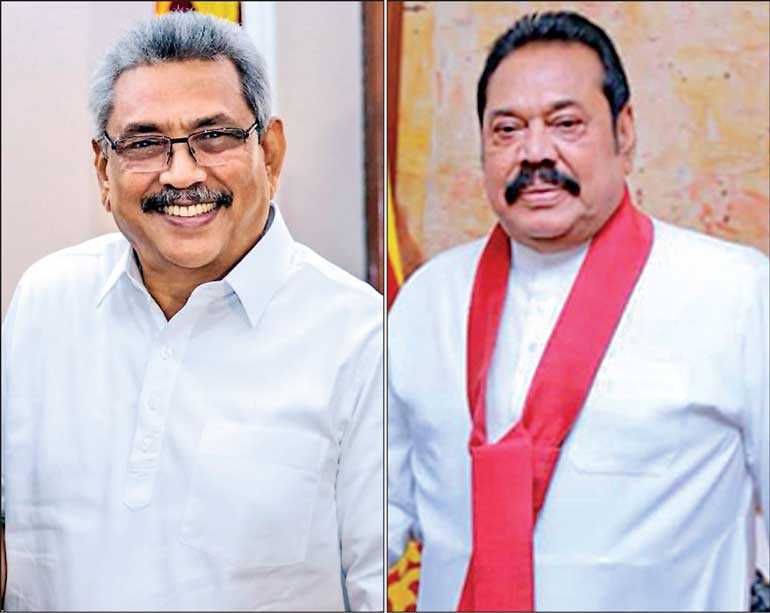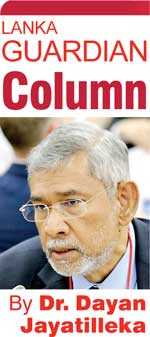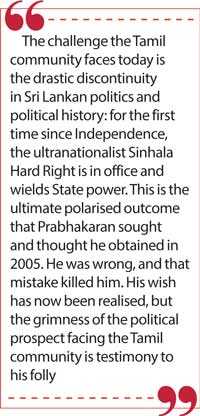Saturday Apr 19, 2025
Saturday Apr 19, 2025
Thursday, 28 May 2020 00:28 - - {{hitsCtrl.values.hits}}

The political prospects of the Tamil people, or if you prefer, the Tamil ethnonational community or Tamil minority are at the dimmest, lowest and most challenging that I can remember, and my memory goes  back to 1972, the hoisting of black flags (occasioning a sensitive Daily News editorial by my father) and the boyhood of Tamil militancy.
back to 1972, the hoisting of black flags (occasioning a sensitive Daily News editorial by my father) and the boyhood of Tamil militancy.
The problem the Tamils face today goes beyond the historic folly of Tamil nationalism not settling for a stalemate with structural reform as in Northern Ireland, instead of supporting to the bitter end a war for a separate state which was utterly lost. The problem they face is similar to that which the Palestinians do, in that there is an ultra-hawkish administration which has decidedly turned its back on the earlier consensus on the nature of the problem and the contours of a solution, and is moving swiftly and unilaterally to shape a final geopolitical outcome of a zero-sum character.
The challenge the Tamil community faces today is the drastic discontinuity in Sri Lankan politics and political history: for the first time since Independence, the ultranationalist Sinhala Hard Right is in office and wields State power.
This is the ultimate polarised outcome that Prabhakaran sought and thought he obtained in 2005. He was wrong, and that mistake killed him. His wish has now been realised, but the grimness of the political prospect facing the Tamil community is testimony to his folly.
Postwar pathways
There were two competing perspectives within the Sri Lankan State when the war was won in May 2009 (as I can attest from personal experience after my UN-Geneva stint). The first was that of the national political leadership: having militarily defeated the Tigers and secessionism, Tamil nationalism would be politically accommodated within the framework pledged by Colombo to Delhi. The second was that of the defence apparatus: having militarily defeated the Tigers, Tamil nationalism would be politically defeated and the ‘military-[Buddhist]clergy complex’ would determine the postwar order.
Having cheered on the losing fascistic side of a bloody war, the Tamils should have prudently retreated into adherence like a finger to a glove, to the formula Delhi had committed Colombo to during wartime and the aftermath of victory. Instead they by-passed 13A, attempted to surpass it, and later, pushed for a new, non-unitary political order utterly incongruent with the historic outcome of the war. They could not leverage India because they were ranging way beyond Indian diplomatic commitment as delimited by the 13th Amendment and “building on” it.
In 2015-2019 those who did nothing to win the war and everything to appease the enemy were striving to determine the postwar order, designing it on the lines of their ideology that opposed and prevented a military victory which could have ended the war much earlier.
Neoliberal-minoritarianism decisively tilted the balance between the two perspectives on the postwar political order, from that of political accommodation (which President Mahinda Rajapaksa was inclined to) to that of the decisive defeat of Tamil nationalism and the dismantling of the Tamil collective political identity project under a ‘National Security/Homeland Security’ dominated postwar order (which President Gotabaya Rajapaksa appears committed to).
Gotabaya Rajapaksa is not the enemy or the danger. An Ideology is. It is an ideology that long antedates him and that he has chosen to espouse—or it has chosen him. Everything changes, and this too can change.
With State power in the hands of the Sinhala Hard Right for the first time, the strategic aim – and prospect—is the end of Tamil political history; the end of history of a specifically Tamil politics, the politics of power-sharing at the centre and autonomy at the periphery, damned in the President’s discourse (Parliament Jan 2020) as “political agendas founded on race…playing the role of king maker…the influence of extremism”.
How to reconcile this with his attribution of his electoral success in his landmark Anuradhapura investiture speech to the “extraordinary blessings of the Buddhists monks” and his identification that “the main message of the election is that it was the Sinhala majority vote that allowed me to win the presidency” – which clearly fit the description of “political agendas founded on race” and “kingmaking”?
Is it that identity politics of the Sinhala Buddhist majority, does not fall into the category of “the politics of race” because the Sinhala majority is the nation in and of itself – and ‘kingmaking’ is its divine right? If the identity politics is that of a minority is it then a “political agenda founded on race” and “kingmaking” not your legitimate right even if you have the parliamentary numbers in proportion to your share of the population (thanks to proportional representation)?
Never since Independence, indeed in living memory, has this been the Social Contract on the island—but it is now.
Philosophically and ideologically, this regime has the lowest ever threshold of tolerance of minority rights, grievances, demands and aspirations—because it does not recognise these as belonging to a legitimate category—and the highest ever ceiling of patronage of majority rights, grievances, demands and aspirations, because these are accorded a higher legitimacy.
From the standpoint of Sri Lankan national and State interest, such ethnoreligious/ethno-lingual unipolarity and unilateralism in a multiethnic, multireligious, multilingual society is profoundly, strategically, counterproductive—causing domination and disequilibrium, polarisation and isolation.
It requires counter-balance and containment. Power must be proportionately distributed, not concentrated and monopolised. Sustainable stability can only be achieved through peaceful coexistence, which requires a balance of power approaching systemic equilibrium.
Sumanthiran symptom
The moderate TNA placed its bets on Ranil’s UNP while placing on it the burden of a new Constitution which would go beyond the 1987 Accord. When even the Geneva 2015 resolution did not go beyond  “implementation of the 13th Amendment”, the TNA expected Ranil’s UNP to supersede it and survive. Together with Geneva 2015, the anti-unitary draft Constitution began the rise to state power of the Sinhala Hard-Right.
“implementation of the 13th Amendment”, the TNA expected Ranil’s UNP to supersede it and survive. Together with Geneva 2015, the anti-unitary draft Constitution began the rise to state power of the Sinhala Hard-Right.
Sumanthiran too was culpable. In a singularly ill-advised remark, he exulted after the Presidential election of January 2015 that the minorities have now shown they have political power equal to that of the majority. While history underscores the lesson of Versailles that those defeated in a war must not be humiliated unless one wished to risk a Hitlerian-Fascist backlash, Tamil nationalism and its neoliberal UNP partners went further in their folly. In the 2015 Geneva resolution and the draft of a new, non-unitary Constitution, they who had no wartime legitimacy attempted to treat the indisputable victors of a thirty-year war as the vanquished. Meanwhile, Wigneswaran’s provocative, eccentric adventurism damaged the very idea of devolution.
Over and above the global nationalist-populist backlash against neoliberal economics and minoritarian identity politics, the Sinhala majority crystallised a determination to stop the cycle of humiliation and put the repetition of such temerity well beyond reach.
Sumanthiran is now being denounced by Tamil ultranationalists for ‘social distancing’ from the LTTE. A significant segment of Tamil political society reveres Prabhakaran and the LTTE as deities and regards any criticism as heresy warranting involuntary immolation. From the point of view of objective Tamil interests and political strategy, the denunciation comes at a crucial time of decision.
Never before
The Tamil Question is quintessentially the question of Tamil political space. That space is being shrunk to the point that it was before G.G. Ponnambalam and S.J.V. Chelvanayakam intervened.
The political dimension of collective Tamil existence is being taken off the table and is going off the radar.
Even under the hard-nosed but pragmatic, permeable administrations of Sirimavo Bandaranaike, the Tamils had more political capacity and wiggle-room.
What the Tamil political community faces today is not merely the first Sri Lankan leadership that is not committed, however grudgingly, to operate within the parameters of the Indo-Sri Lanka Accord and the 13th Amendment, but the first Sri Lankan leadership since the post-1983 ‘shuttle diplomacy’ of G. Parthasarthy Sr. and the understandings of 1984-’86, to feel itself unconstrained by the formula of devolution of power to the provincial level as a political solution to the Tamil Question.
What is more, this is the first leadership since the Jayewardene UNP manifesto of 1977, to reject the very existence of legitimate Tamil political grievances and the requirement of a negotiated (bilateral or ‘all-parties roundtable conference’) political solution.
This is also the first Sri Lankan/Ceylonese leadership, ever, that is willing to deploy armed troops where there is no violent activism or even non-violent agitation such as the 1961 Satyagraha. That cannot be doubted by anyone who watched on TV news, the line of motorcycle-riding armed rapid deployment troops rolling into a Muslim neighbourhood in Maligawatte where there was no riot, but a stampede in which three women tragically died during an ill-planned distribution of cash to the poor for Ramadan.
This is the first-ever Sinhala leadership unwilling to countenance and engage in political negotiation over Tamil political grievances, demands and aspirations – which every leader from DS Senanayake did, even when they refused to concede. (The Tamils should have accepted his 60:40 counter-offer.)
With the dirge of the Easter requiem as finale, minoritarian-neoliberal “shock therapy” only awakened and accelerated the emergence from the lower depths of the collective Sinhala psyche, the resolve to ‘solve’ the Tamil and Muslim questions permanently and unilaterally. The agenda dates back through the hawkish policies of National Security Minister Lalith Athulathmudali in the mid-1980s, to the ACBC representations in the 1940s for the declaration of a Sinhala Buddhist state, which Prime Minister D.S. Senanayake rejected with characteristic realism.
In its current incarnation the phenomenon is best understood as armed Anagarika Dharmapala-ism; Dharmapalaism in power.
With the Tamil attempt to bypass 13A, the product of the breakthrough Accord, the problem shifted to one of renewed and protracted deadlock in political negotiation. Now that deadlock is being dissolved by Sinhala ultranationalist unilateralism.
The Far-Right bucket list is of total structural counterreformation and transformation in all dimensions, to ‘eliminate’ the problem root-and-branch, and structurally ‘lockdown’ minority assertiveness, ensuring an unassailable systemic hegemony for Sinhala-Buddhist nationalism.
This ideological matrix can be glimpsed in President Rajapaksa’s Twitter message that: “At 2nd mtng of Buddhist Advisory Council, I appointed a Task Force led by Secy Defence to conduct survey of archaeological sites in the East and to take action to preserve them, due to concerns raised about their destruction. Historical sites are the heritage of all Sri Lankans.”
The President’s paradigm brings purely civilian, scientific-scholarly activities such as archaeology under the rubric of Defence and the control of former military top-brass, in concert with an influential caucus of the Buddhist clergy. It assertively tilts the balance in an area in which the three major communities are equally balanced in terms of population ratios. Given the correct invocation of “the heritage of all Sri Lankans” in the President’s tweet, it may have been more appropriate to appoint a Task Force representing “all Sri Lankans”, or at least “all Sri Lankans” living in the east.
Veteran correspondent P.K. Balachandran has unearthed the Sinhala Far-Right’s Eastern agenda in a recent piece. (https://www.thecitizen.in/index.php/en/NewsDetail/index/6/18792/Why-Rajapaksa-Has-Brought-Archaeology-Preservation-Under-His-Defense-Secretary-)
About matters more generally, the President reassuringly added that “Intelligence Unit has been vested with full powers to deal with issues”. (http://www.pmdnews.lk/presidential-task-force-to-protect-archaeological-sites/)
Meanwhile, as Chandani Kirinde reports, the Academy of Financial Studies of the Finance Ministry, as well as the Multipurpose Development Task Force, have just been brought under the Ministry of Defence.
Delhi dimension
The most telling and portentous moment in the Gotabaya Rajapaksa presidency so far, was the scene that showed him demarcate himself from all his predecessors, during his appearance at the media briefing together with his host, Prime Minister Modi, on his maiden visit to Delhi as Head of State.
Prime Minister Modi specifically mentioned the “implementation of the 13th Amendment”, repeating it in English. President Rajapaksa impassively ignored the reference and did not make even a polite, token acknowledgment of it. There was no reciprocity or show of recognition of the Indian PM’s concern. Instead, in two interviews given to the Indian media after Modi’s mention, President Rajapaksa pushed back on devolution, a political solution and the 13th Amendment, changing the goalposts. He has hit ‘delete’ on the wartime commitment made to Delhi by the Troika which included him.
This is the first leadership in 35 years to rupture with the paradigm of and charter for Sri Lankan society as contained in the five clauses of Article 1 of the Indo-Sri Lanka Accord of 1987. The agenda is to bury the Accord.
To my mind, India’s Sri Lanka policy cannot but comprise, and toggle between, multiple considerations and concerns:
(1) Balancing China through competitive constructive (mainly economic) engagement with Colombo.
(2) Strategic apprehension at an axis between China’s PLA and Sri Lanka’s military-dominated new establishment and the potential of a second or proto-Pakistan on India’s Southern flank.
(3) Perspectives of India’s grand-strategic partner the US about Chinese influence in the Indian Ocean region.
(4) RSS empathy with Sinhala-Buddhist ultranationalist Islamophobia.
(5) Latent Tamil Nadu disaffection over a Sri Lankan militarisation and roll-back of residual autonomy which Delhi obtained for its ethnic kin, the Lankan Tamils.
(6) The political weakening of the Lankan Tamils of the island’s north-east, potentially a geopolitically countervailing constituency due to ethno-lingual kinship, in strategic Indian Ocean competition.
Tamil democratic bloc
“Soft power” and moral-ethical hegemony are the most vital resources in an asymmetric equation of power. Where are the North-Eastern Tamil Gramscians? While the Tamil community, its narrative and situation garner a measure of soft power internationally, the cult of a terrorist leader and his suicide-bombing militia cannot but landmine access routes to the moral high ground.
Exorcising Prabhakaran is a modest price for strategic space to escape domestic encirclement. Even the most liberal-democratic administration—say, Joe Biden’s—will find the deification of a suicide-bombing terrorist chieftain and militia impossible to swallow. And no strategic partner will cross a bipartisan Indian red-line.
The LTTE fan-club in the UK/West is unmoved by manner in which the successor generation of the Sinn Fein has left behind the discourse and symbolism of ‘the Troubles’.
Russian scholar-diplomats and practitioners who have spent decades on the Middle East, including in Moscow’s hosting of unity talks between Palestinian factions, told me that a united front between the PLO/PA and Hamas is a prerequisite for any progress in the Palestinian cause. Even the planned re-annexation of the West Bank has failed to unite the Palestinians.
The Tamils can do no better than study and seek political counsel from Sinn Fein and the ANC. President Cyril Ramaphosa, former Special Envoy for Sri Lanka, could be a wellspring of wisdom.
If the Tamil community wishes to avoid committing collective politicide, all factions must converge on a social democratic platform organically fused with the Indo-Lanka Accord and the realisation and defence of its enlightened vision and structural reforms.
In the final analysis, all that stands between the Lankan Tamil community and the end of Tamil political history on the island, is India.
Discover Kapruka, the leading online shopping platform in Sri Lanka, where you can conveniently send Gifts and Flowers to your loved ones for any event including Valentine ’s Day. Explore a wide range of popular Shopping Categories on Kapruka, including Toys, Groceries, Electronics, Birthday Cakes, Fruits, Chocolates, Flower Bouquets, Clothing, Watches, Lingerie, Gift Sets and Jewellery. Also if you’re interested in selling with Kapruka, Partner Central by Kapruka is the best solution to start with. Moreover, through Kapruka Global Shop, you can also enjoy the convenience of purchasing products from renowned platforms like Amazon and eBay and have them delivered to Sri Lanka.
Discover Kapruka, the leading online shopping platform in Sri Lanka, where you can conveniently send Gifts and Flowers to your loved ones for any event including Valentine ’s Day. Explore a wide range of popular Shopping Categories on Kapruka, including Toys, Groceries, Electronics, Birthday Cakes, Fruits, Chocolates, Flower Bouquets, Clothing, Watches, Lingerie, Gift Sets and Jewellery. Also if you’re interested in selling with Kapruka, Partner Central by Kapruka is the best solution to start with. Moreover, through Kapruka Global Shop, you can also enjoy the convenience of purchasing products from renowned platforms like Amazon and eBay and have them delivered to Sri Lanka.